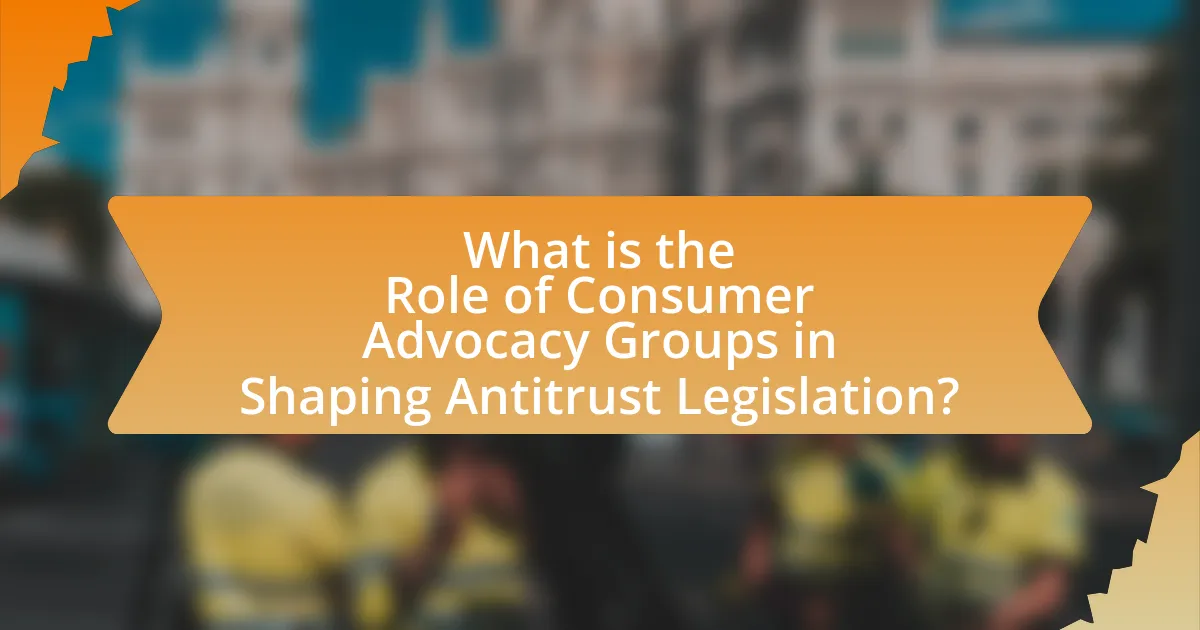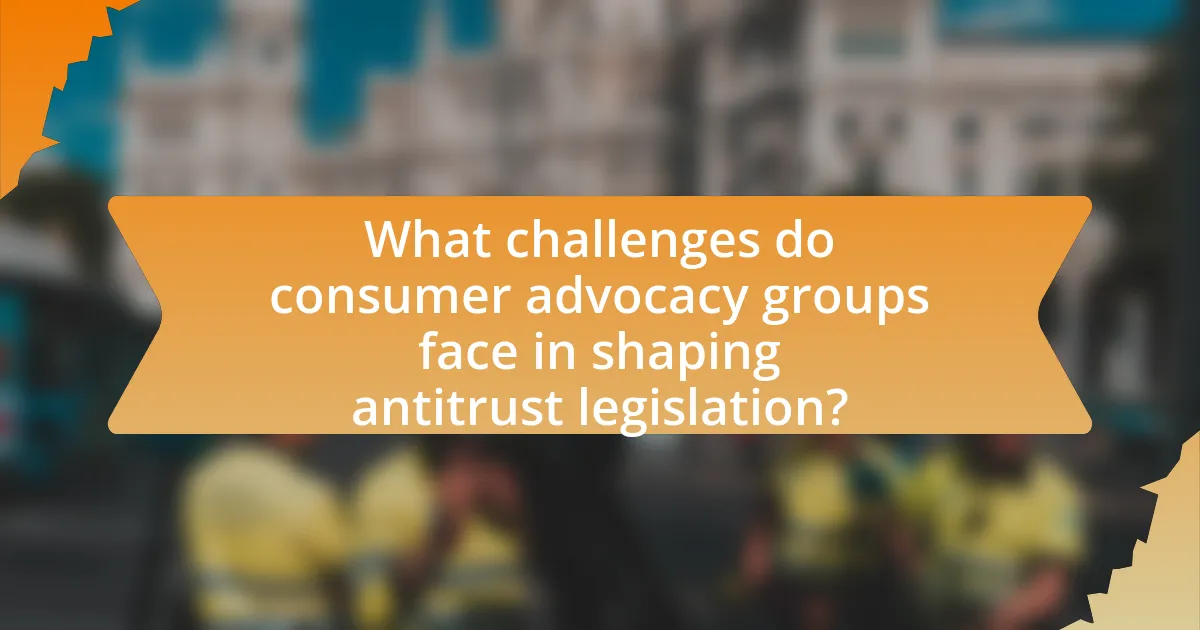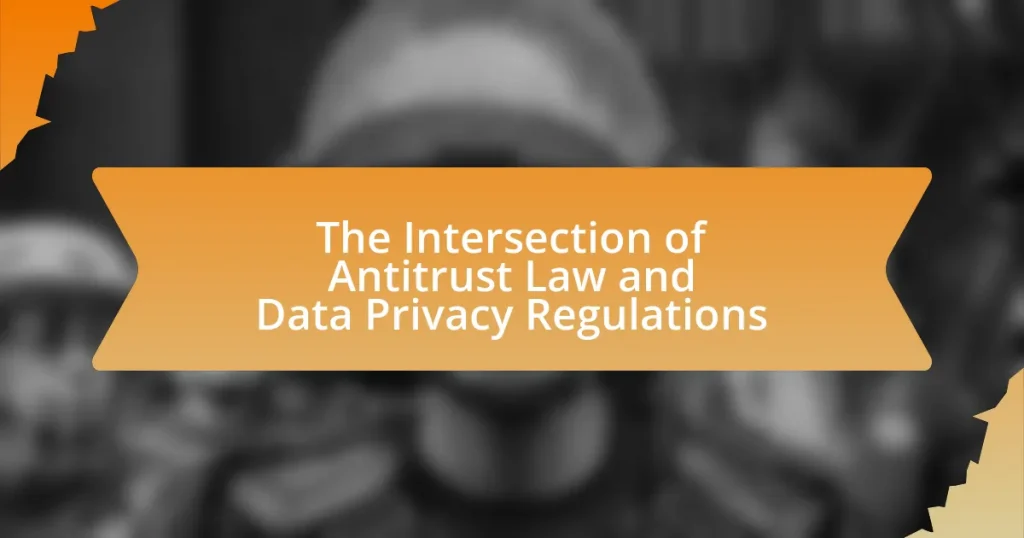Consumer advocacy groups play a vital role in shaping antitrust legislation by representing consumer interests and promoting fair competition. These organizations engage in research, public education, and lobbying to influence policymakers, as evidenced by their opposition to monopolistic practices that harm consumers. Key strategies employed by these groups include coalition building, public awareness campaigns, and direct lobbying efforts, which enhance their effectiveness in advocating for stronger antitrust laws. Despite facing challenges such as limited resources and opposition from corporate interests, consumer advocacy groups have successfully influenced significant legislation and continue to address emerging issues in the digital economy. Their efforts ensure that consumer welfare remains a priority in legislative discussions surrounding antitrust policies.

What is the Role of Consumer Advocacy Groups in Shaping Antitrust Legislation?
Consumer advocacy groups play a crucial role in shaping antitrust legislation by representing the interests of consumers and promoting fair competition. These organizations engage in research, public education, and lobbying efforts to influence policymakers and regulatory bodies. For instance, groups like the Consumer Federation of America have historically campaigned for stronger antitrust enforcement, arguing that monopolistic practices harm consumers through higher prices and reduced choices. Their advocacy efforts often lead to increased scrutiny of mergers and acquisitions, as seen in the opposition to the proposed merger between AT&T and Time Warner, which raised concerns about market concentration and consumer impact. By providing data, expert testimony, and mobilizing public opinion, consumer advocacy groups significantly contribute to the development and reform of antitrust laws, ensuring that consumer welfare remains a priority in legislative discussions.
How do consumer advocacy groups influence antitrust policy?
Consumer advocacy groups influence antitrust policy by mobilizing public opinion, conducting research, and lobbying government officials. These organizations raise awareness about anti-competitive practices, which can lead to increased scrutiny from regulators. For example, the Consumer Federation of America has successfully advocated for stronger enforcement of antitrust laws by presenting data on market monopolization and its negative effects on consumers. Their efforts often result in legislative proposals aimed at enhancing competition and protecting consumer rights, demonstrating their significant role in shaping antitrust policy.
What strategies do these groups employ to advocate for change?
Consumer advocacy groups employ strategies such as lobbying, public awareness campaigns, and coalition building to advocate for change in antitrust legislation. Lobbying involves direct engagement with lawmakers to influence policy decisions, as seen in the efforts of organizations like the Consumer Federation of America, which actively communicates with legislators to promote consumer-friendly regulations. Public awareness campaigns aim to educate the public about the implications of monopolistic practices, utilizing social media and traditional media to amplify their message, exemplified by campaigns that highlight the negative effects of corporate consolidation on prices and choices. Coalition building involves partnering with other organizations, including labor unions and environmental groups, to create a unified front that strengthens their advocacy efforts, as demonstrated by the collaboration between consumer groups and labor organizations during the push for stronger antitrust enforcement in the 2021 Congressional hearings.
How do consumer advocacy groups collaborate with lawmakers?
Consumer advocacy groups collaborate with lawmakers by providing research, expert testimony, and grassroots mobilization to influence policy decisions. These groups often conduct studies that highlight consumer issues, which they present to lawmakers to inform legislative agendas. For instance, organizations like the Consumer Federation of America regularly engage in lobbying efforts, offering data and case studies that demonstrate the need for stronger consumer protections. Additionally, they mobilize public support through campaigns that encourage constituents to contact their representatives, thereby amplifying their influence on legislative processes. This collaboration is crucial in shaping antitrust legislation, as it ensures that consumer perspectives are considered in the development of laws aimed at promoting fair competition and protecting consumer rights.
Why are consumer advocacy groups important in the context of antitrust legislation?
Consumer advocacy groups are important in the context of antitrust legislation because they represent the interests of consumers, ensuring that market competition remains fair and equitable. These groups actively monitor corporate practices and lobby for regulations that prevent monopolistic behaviors, which can harm consumers through higher prices and reduced choices. For instance, the American Antitrust Institute has documented cases where consumer advocacy has led to significant legal actions against companies engaging in anti-competitive practices, demonstrating their role in promoting consumer welfare and market integrity.
What impact do these groups have on public awareness of antitrust issues?
Consumer advocacy groups significantly enhance public awareness of antitrust issues by educating the public about monopolistic practices and their consequences. These organizations conduct research, publish reports, and engage in campaigns that highlight the importance of competition in the marketplace. For instance, the American Antitrust Institute has produced numerous studies demonstrating how reduced competition leads to higher prices and fewer choices for consumers. By disseminating this information through various media channels, these groups mobilize public opinion and encourage consumer activism, ultimately influencing policymakers to consider antitrust reforms.
How do consumer advocacy groups represent the interests of the public?
Consumer advocacy groups represent the interests of the public by actively promoting consumer rights, ensuring fair market practices, and influencing policy decisions. These organizations conduct research, gather data on consumer issues, and mobilize public opinion to advocate for regulations that protect consumers from unfair business practices. For example, the Consumer Federation of America has successfully lobbied for stronger consumer protection laws, demonstrating their role in shaping legislation that directly benefits the public. Additionally, they often provide resources and education to consumers, empowering individuals to make informed choices and voice their concerns effectively.

What challenges do consumer advocacy groups face in shaping antitrust legislation?
Consumer advocacy groups face significant challenges in shaping antitrust legislation, primarily due to limited resources and political influence. These groups often operate with smaller budgets compared to well-funded corporate lobbyists, which restricts their ability to conduct extensive research, mobilize public support, and engage in lobbying efforts. Additionally, the complexity of antitrust laws and the political landscape can hinder their effectiveness; for instance, large corporations frequently have established relationships with lawmakers, allowing them to exert considerable influence over legislative processes. Furthermore, consumer advocacy groups may struggle to unify diverse consumer interests, making it difficult to present a cohesive agenda that resonates with policymakers. These factors collectively impede their capacity to advocate for stronger antitrust protections effectively.
How do funding and resources affect their advocacy efforts?
Funding and resources significantly enhance the advocacy efforts of consumer advocacy groups by enabling them to conduct research, mobilize campaigns, and influence policy. Adequate financial support allows these groups to hire experts, produce informative materials, and engage in public outreach, which amplifies their message and increases their visibility. For instance, a study by the Center for American Progress found that well-funded advocacy organizations are more effective in lobbying for legislative changes, as they can allocate resources towards strategic initiatives and coalition-building. This financial backing directly correlates with their ability to impact antitrust legislation, as seen in cases where consumer groups successfully campaigned for stronger regulations against monopolistic practices.
What role does public support play in their effectiveness?
Public support significantly enhances the effectiveness of consumer advocacy groups in shaping antitrust legislation. When these groups mobilize public opinion, they can influence policymakers and create pressure for regulatory changes. For instance, a study by the American Antitrust Institute found that public campaigns led by advocacy groups resulted in increased awareness and support for antitrust enforcement, which directly correlated with legislative action. This demonstrates that strong public backing not only legitimizes the efforts of these groups but also amplifies their impact on the legislative process.
How do political dynamics influence their ability to enact change?
Political dynamics significantly influence consumer advocacy groups’ ability to enact change in antitrust legislation. These dynamics include the political climate, party control, and the relationships between advocacy groups and policymakers. For instance, during periods of bipartisan support for antitrust reform, consumer advocacy groups can more effectively lobby for changes, as seen in the 2021 Congressional hearings on Big Tech, where increased scrutiny led to proposed legislation aimed at enhancing competition. Conversely, when political polarization is high, advocacy efforts may be stymied, as seen in the stalled antitrust bills in 2022, where partisan divides hindered progress. Thus, the interplay of political factors directly impacts the effectiveness of consumer advocacy groups in shaping antitrust laws.
What opposition do consumer advocacy groups encounter?
Consumer advocacy groups encounter significant opposition from powerful corporate interests and regulatory bodies. These entities often resist changes proposed by advocacy groups that aim to enhance consumer protections and promote fair competition. For instance, large corporations may lobby against antitrust legislation that consumer advocacy groups support, arguing that such regulations could hinder economic growth and innovation. Additionally, regulatory agencies may face pressure from these corporations, leading to a reluctance to enforce existing consumer protection laws or to adopt new measures that could benefit consumers. This dynamic illustrates the challenges consumer advocacy groups face in their efforts to influence antitrust legislation effectively.
How do corporate interests challenge their initiatives?
Corporate interests challenge their initiatives by prioritizing profit over consumer welfare, often leading to lobbying against regulations that promote fair competition. For instance, large corporations may exert influence on policymakers to weaken antitrust laws, thereby undermining the efforts of consumer advocacy groups aimed at protecting market competition. This dynamic is evident in cases where companies have successfully lobbied for exemptions or delays in the enforcement of antitrust regulations, which can stifle the initiatives of advocacy groups seeking to ensure equitable market practices.
What legal barriers exist for consumer advocacy groups?
Consumer advocacy groups face several legal barriers, including limitations on funding, restrictions on lobbying activities, and challenges in accessing information. These groups often struggle with financial constraints due to regulations that limit the sources and amounts of funding they can receive, which can hinder their ability to operate effectively. Additionally, laws governing lobbying can restrict their capacity to influence legislation, as they may be required to register and report their activities, creating administrative burdens. Furthermore, consumer advocacy groups may encounter difficulties in obtaining necessary data from corporations or government entities, as legal protections for proprietary information can obstruct transparency and accountability efforts.

What are the outcomes of consumer advocacy efforts in antitrust legislation?
Consumer advocacy efforts in antitrust legislation have led to increased scrutiny of monopolistic practices and the implementation of more consumer-friendly regulations. These outcomes include the establishment of stronger antitrust laws, such as the Clayton Act and the Sherman Act, which were influenced by consumer groups advocating for fair competition. Additionally, consumer advocacy has resulted in significant legal actions against major corporations, such as the antitrust case against Microsoft in the late 1990s, which aimed to dismantle its monopolistic practices and promote market competition. These efforts have ultimately contributed to a more equitable marketplace, ensuring that consumer interests are prioritized in legislative processes.
How have consumer advocacy groups successfully influenced past legislation?
Consumer advocacy groups have successfully influenced past legislation by mobilizing public opinion, conducting research, and lobbying policymakers. For instance, the Consumer Federation of America played a crucial role in the passage of the Dodd-Frank Wall Street Reform and Consumer Protection Act in 2010, which aimed to increase consumer protections in the financial sector. Their efforts included extensive campaigns that highlighted the need for stronger regulations following the 2008 financial crisis, effectively swaying legislators to prioritize consumer interests. Additionally, advocacy groups have utilized grassroots movements to raise awareness and pressure lawmakers, exemplified by the successful campaign against the proposed merger of Comcast and Time Warner, which was ultimately abandoned due to public opposition fueled by consumer advocates.
What specific laws or regulations have been shaped by these groups?
Consumer advocacy groups have significantly influenced antitrust legislation, notably through the shaping of the Clayton Antitrust Act of 1914 and the Hart-Scott-Rodino Antitrust Improvements Act of 1976. These groups advocated for stronger regulations to prevent monopolistic practices and promote fair competition, leading to the inclusion of provisions that address anti-competitive mergers and acquisitions. Their efforts have been instrumental in the enforcement of consumer protection laws, which aim to safeguard consumer interests against corporate abuses.
How do these outcomes affect consumers and the market?
Outcomes from consumer advocacy groups shaping antitrust legislation significantly benefit consumers and the market by promoting fair competition and preventing monopolistic practices. When these groups successfully advocate for stricter antitrust laws, consumers experience lower prices, improved product quality, and greater choices in the marketplace. For instance, the enforcement of antitrust regulations against large corporations has historically led to the breakup of monopolies, such as the case with AT&T in the 1980s, which resulted in increased competition in the telecommunications sector. This increased competition not only empowers consumers but also stimulates innovation and economic growth within the market.
What future trends can be anticipated for consumer advocacy groups in antitrust legislation?
Future trends for consumer advocacy groups in antitrust legislation include increased collaboration with technology experts and a focus on digital market regulations. As digital platforms grow in influence, advocacy groups are likely to push for stricter regulations to ensure fair competition and protect consumer rights. For instance, the rise of monopolistic practices in tech industries has prompted groups to advocate for transparency and accountability, as seen in recent legislative efforts like the American Innovation and Choice Online Act. This trend reflects a broader movement towards addressing the complexities of digital economies and ensuring that consumer interests are prioritized in legislative frameworks.
How might technology impact their advocacy strategies?
Technology significantly enhances consumer advocacy groups’ strategies by enabling more effective communication and mobilization. Digital platforms allow these groups to reach larger audiences quickly, facilitating grassroots campaigns and real-time engagement. For instance, social media has been instrumental in organizing protests and spreading awareness about antitrust issues, as evidenced by the rapid mobilization of support for legislation like the American Innovation and Choice Online Act. Additionally, data analytics tools empower advocacy groups to analyze consumer behavior and market trends, providing evidence-based arguments that strengthen their positions in legislative discussions. This technological integration not only amplifies their voice but also increases their influence in shaping antitrust legislation.
What emerging issues are likely to be addressed by these groups?
Consumer advocacy groups are likely to address emerging issues such as digital monopolies, data privacy, and the impact of artificial intelligence on market competition. These groups focus on ensuring fair competition and protecting consumer rights in rapidly evolving markets. For instance, the rise of tech giants has led to concerns about monopolistic practices that stifle competition, prompting advocacy for stronger antitrust enforcement. Additionally, as data privacy becomes a critical concern, these groups advocate for regulations that protect consumer information from exploitation. The increasing use of artificial intelligence also raises questions about fairness and transparency in algorithms, which consumer advocacy groups aim to address through legislative reforms.
What best practices can consumer advocacy groups adopt to enhance their impact?
Consumer advocacy groups can enhance their impact by employing strategic coalition-building, effective communication, and data-driven advocacy. Coalition-building allows these groups to unite with other organizations, amplifying their voice and resources, which has been shown to increase influence in legislative processes. Effective communication, including clear messaging and targeted outreach, ensures that the concerns of consumers are articulated in a way that resonates with policymakers and the public. Data-driven advocacy, supported by research and statistics, provides concrete evidence to back claims, making arguments more compelling; for instance, studies have demonstrated that consumer groups utilizing empirical data are more successful in influencing antitrust legislation outcomes.
How can these groups effectively engage with the public and stakeholders?
Consumer advocacy groups can effectively engage with the public and stakeholders by utilizing transparent communication strategies and fostering collaborative relationships. These groups should prioritize clear messaging that outlines their objectives and the implications of antitrust legislation on consumers. For instance, they can host public forums and workshops to educate stakeholders about the importance of fair competition, thereby increasing public awareness and involvement. Additionally, leveraging social media platforms allows these groups to reach a broader audience, facilitating real-time interaction and feedback. Research indicates that organizations that actively involve stakeholders in discussions about policy changes tend to achieve higher levels of public trust and support, as seen in the successful campaigns led by groups like the Consumer Federation of America.
What role does education play in their advocacy efforts?
Education plays a crucial role in the advocacy efforts of consumer advocacy groups by equipping individuals with knowledge about their rights and the implications of antitrust legislation. Through educational initiatives, these groups raise awareness about monopolistic practices and promote informed consumer choices, which can lead to increased public engagement in advocacy efforts. For instance, studies have shown that informed consumers are more likely to support policies that enhance competition and protect consumer interests, thereby influencing legislative outcomes.



